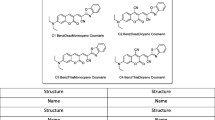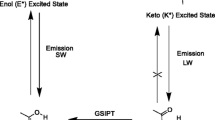Abstract
The molecular structure, UV-visible spectra, and optical properties of D-π-A conjugated organic dye molecules (Disperse Red 1 (DR1) and Disperse Red 73 (DR73)) were analyzed using density functional theory (DFT) and time-dependent density functional theory (TD-DFT) and compared with azobenzene molecule to study the effect of donor and acceptor substituents on the molecular properties. The performance of DFT functionals is investigated using B3LYP hybrid functional and three long-range corrected functionals (CAM-B3LYP, LC-ω PBE, and ω B97XD) in conjunction with 6-31G(d,p) basis set. Using TD-DFT, we calculate the vertical excitation energies and transition dipole moment values for 100 excited states. These values were further utilized to calculate frequency dependent polarizability under sum-over-states (SOS) formalism and refractive index of these molecular systems. We observe that for azobenzene and DR1 molecules, ω B97XD predicted wavelengths corresponding to peak absorbance closest to the experimental results, while for DR73 molecule, B3LYP gave better prediction. Large polarizability response is also observed for these molecules (DR1 and DR73) in comparison to parent azobenzene structure due to charge transfer between donor and acceptor groups. For DR1 and DR73 molecules, αxx component of polarizability dominates in contrast to azobenzene where αyy dominates. The HOMO → LUMO transition during excitation contributes to the peak molecular response in simulated UV-visible spectra. The high polarizability response of selected D-π-A conjugated molecules in comparison to parent molecule suggests that these molecules are promising candidates for tailor-made photonic and optoelectronic device development.

Functional and substituent effect on the optical response of D-π-A conjugated molecules modelled using DFT and TDDFT.












Similar content being viewed by others
References
Mustroph H, Stollenwerk M, Bressau V (2006) Current developments in optical data storage with organic dyes. Angew Chem Int Ed 45:2016–2035. https://doi.org/10.1002/anie.200502820
Mishra A, Fischer MK, Bäuerle P (2009) Metal-free organic dyes for dye-sensitized solar cells: From structure: Property relationships to design rules. Angew Chem Int Ed 48:2474–2499. https://doi.org/10.1002/anie.200804709
Kakiage K, Aoyama Y, Yano T, Otsuka T, Kyomen T, Unno M, Hanaya M (2014) An achievement of over 12 percent efficiency in an organic dye-sensitized solar cell. Chem Comm 50:6379–6381. https://doi.org/10.1039/C4CC02192D
Kuehne AJ, Gather MC (2016) Organic lasers: recent developments on materials, device geometries, and fabrication techniques. Chem Rev 116:12823–12864. https://doi.org/10.1021/acs.chemrev.6b00172
Clark J, Lanzani G (2010) Organic photonics for communications. Nat Photonics 4:438–446. https://doi.org/10.1038/nphoton.2010.160
Haley JE (2020) Development of organic nonlinear optical materials for light manipulation. In: Women in aerospace materials. https://doi.org/10.1007/978-3-030-40779-7_3. Springer, Cham, pp 35–47
Pramodini S, Poornesh P (2014) Third-order nonlinear optical response of indigo carmine under 633 nm excitation for nonlinear optical applications. Opt Laser Technol 63:114–119. https://doi.org/10.1016/j.optlastec.2014.04.007
Kim TD, Lee KS (2015) D-π-A conjugated molecules for optoelectronic applications. Macromol Rapid Commun 36:943–958. https://doi.org/10.1002/marc.201400749
Khan MU, Ibrahim M, Khalid M, Braga AAC, Ahmed S, Sultan A (2019) Prediction of second-order nonlinear optical properties of D–π–a compounds containing novel fluorene derivatives: a promising route to giant hyperpolarizabilities. J Clust Sci 30:415–430. https://doi.org/10.1007/s10876-018-01489-1
Bouzineb Y, Slimi A, Raftani M, Fitri A, Benjelloun AT, Benzakour M, Mcharfi M, Bouachrine M (2020) Theoretical study of organic sensitizers based on 2, 6-diphenyl-4H-pyranylidene/1, 3, 4-oxadiazole for dye-sensitized solar cells. J Mol Model 1–12(2020):26. https://doi.org/10.1007/s00894-020-04611-1
El Mzioui S, Bouzzine SM, Sidir İ, Bouachrine M, Bennani MN, Bourass M, Hamidi M (2019) Theoretical investigation on π,-spacer effect of the D–π–A organic dyes for dye-sensitized solar cell applications: A DFT and TD-BHandH study. J Mol Model 25:92. https://doi.org/10.1007/s00894-019-3963-1
Nahata A, Shan J, Yardley JT, Wu C (1993) Electro-optic determination of the nonlinear-optical properties of a covalently functionalized Disperse Red 1 copolymer. J Opt Soc Am B 10:1553–1564. https://doi.org/10.1364/JOSAB.10.001553
Coe BJ (1999) Molecular materials possessing switchable quadratic nonlinear optical properties. Chem Eur J 5:2464–2471. https://doi.org/10.1002/(SICI)1521-3765(19990903)5:9∖(∖langle∖)2464::AID-CHEM2464∖(∖rangle∖)3.0.CO;2-L
Kippelen B, Peyghambarian N, Lyon SR, Padias AB, Hall HK (1994) Dual-grating formation through photorefractivity and photoisomerization in azo-dye-doped polymers. Opt Lett 19:68–70. https://doi.org/10.1364/OL.19.000068
Li J, Jiang P, Wei C, Shi J (2008) Linear and nonlinear optical properties of covalently bound CI Disperse Red 1 chromophore/silica hybrid film. Dyes Pigm 78:219–224. https://doi.org/10.1016/j.dyepig.2007.12.005
Blasco E, Piñol M, Berges C, Sánchez-Somolinos C, Oriol L (2019) Smart polymers for optical data storage, smart polymers and their applications. Woodhead Publishing, US, pp 567–606. https://doi.org/10.1016/B978-0-08-102416-4.00016-8
Wu J, Wang W, Wang N, He J, Deng G, Li Z, Zhang X, Xiao H, Chen K (2018) Structure–property analysis of julolidine-based nonlinear optical chromophores for the optimization of microscopic and macroscopic nonlinearity. Phys Chem Chem Phys 20:23606–23615. https://doi.org/10.1039/C8CP04470H
Ojanen J, Rantala TT (2009) Electronic structure and absorption spectrum of Disperse Red 1: comparison of computational approaches. Open. Chem Phy J 2:37–46. https://doi.org/10.2174/1874412500902010037
Poprawa-Smoluch M, Baggerman J, Zhang H, Maas HP, De Cola L, Brouwer AM (2006) Photoisomerization of Disperse Red 1 studied with transient absorption spectroscopy and quantum chemical calculations. J Phys Chem A 110:11926–11937. https://doi.org/10.1021/jp054982b
Bhalekar SB, Bhagwat AA, Sekar N (2020) Orange-red fluorescent (partially rigidified) donor-π-(rigidified)-acceptor system-computational studies. J Fluoresc 30:565–579. https://doi.org/10.1007/s10895-020-02506-1
Bhalekar S, Avhad K, Sekar N (2020) Deep Red emitting dicyanovinylene isophorone based chromophores: Combined synthesis, optical properties, viscosity sensitivity, and DFT studies. J Photochem Photobiol A 391:112389. https://doi.org/10.1016/j.jphotochem.2020.112389
Boukabcha N, Djafri A, Megrouss Y, Tamer Ö, Avcı D, Tuna M, Dege N, Chouaih A, Atalay Y, Hamzaoui F (2019) Synthesis, crystal structure, spectroscopic characterization and nonlinear optical properties of (Z)-N’-(2, 4-dinitrobenzylidene)-2-(quinolin-8-yloxy) acetohydrazide. J Mol Struct 1194:112–123. https://doi.org/10.1016/j.molstruc.2019.05.074
Arıoğlu Ç, Tamer Ö, Avcı D, Atalay Y (2018) Optimized geometry, spectroscopic characterization and nonlinear optical properties of carbazole picrate: a density functional theory study. Indian J Phys 92:1613–1621. https://doi.org/10.1007/s12648-018-1258-5
Jacquemin D, Perpète E A, Medved M, Scalmani G, Frisch MJ, Kobayashi R, Adamo C (2007) First hyperpolarizability of polymethineimine with long-range corrected functionals. J Chem Phys 126:191108. https://doi.org/10.1063/1.2741246
Helgaker T, Jorgensen P, Olsen J (2014) Chapter 8, Gaussian basis sets, Molecular electronic-structure theory. John Wiley, New York
Frisch MJ, Trucks GW, Schlegel HB, Scuseria GE, Robb MA, Cheeseman JR, Scalmani G, Barone V, Petersson GA, Nakatsuji H, Li X, Caricato M, Marenich AV, Bloino J, Janesko BG, Gomperts R, Mennucci B, Hratchian HP, Ortiz JV, Izmaylov AF, Sonnenberg JL, Williams-Young D, Ding F, Lipparini F, Egidi F, Goings J, Peng B, Petrone A, Henderson T, Ranasinghe D, Zakrzewsk VG, Gao J, Rega N, Zheng G, Liang W, Hada M, Ehara M, Toyota K, Fukuda R, Hasegawa J, Ishida M, Nakajima T, Honda Y, Kitao O, Nakai H, Vreven T, Throssell K, Montgomery JA Jr, Peralta JE, Ogliaro F, Bearpark MJ, Heyd JJ, Brothers EN, Kudin KN, Staroverov VN, Keith TA, Kobayashi R, Normand J, Raghavachari K, Rendell AP, Burant JC, Iyengar SS, Tomasi J, Cossi M, Millam JM, Klene M, Adamo C, Cammi R, Ochterski JW, Martin RL, Morokuma K, Farkas O, Foresman JB, Fox DJ (2016) Gaussian 16, Revision A.03. Gaussian, Inc., Wallingford CT
Perdew JP, Schmidt K (2001) Jacob’s ladder of density functional approximations for exchange correlation energy. AIP Conf Proc Am Inst Phys 577:1. https://doi.org/10.1063/1.1390175
Champagne B, Perpète E A, Jacquemin D, Van Gisbergen SJ, Baerends EJ, Soubra-Ghaoui C, Robins KA, Kirtman B (2000) Assessment of conventional density functional schemes for computing the dipole moment and hyperpolarizabilities of push-pull π conjugated systems. J Phys Chem A 104:4755–4763. https://doi.org/10.1021/jp993839d
Becke AD (1993) Density-functional thermochemistry. III. The role of exact exchange. J Chem Phys 98:5648. https://doi.org/10.1063/1.464913
Savin A (1996). In: Seminario JM (ed) Recent developments and applications of modern density functional theory. Elsevier, Amsterdam, p 327
Iikura H, Tsuneda T, Yanai T, Hirao K (2001) A long-range correction scheme for generalized-gradient-approximation exchange functionals. J Chem Phys 115:3540. https://doi.org/10.1063/1.1383587
Yanai T, Tew DP, Handy NC (2004) A new hybrid exchange–correlation functional using the Coulomb-attenuating method (CAM-B3LYP). Chem Phys Lett 393:51–57. https://doi.org/10.1016/j.cplett.2004.06.011
Peach MJ, Benfield P, Helgaker T, Tozer DJ (2008) Excitation energies in density functional theory: An evaluation and a diagnostic test. J Chem Phys 128:044118. https://doi.org/10.1063/1.2831900
Vydrov OA, Scuseria GE (2006) Assessment of a long-range corrected hybrid functional. J Chem Phys 125:234109. https://doi.org/10.1063/1.2409292
Chai JD, Head-Gordon M (2008) Long-range corrected hybrid density functionals with damped atom–atom dispersion corrections. Phys Chem Chem Phys 10:6615–6620. https://doi.org/10.1039/B810189B
Bouwstra JA, Schouten A, Kroon J (1983) Structural studies of the system trans-azobenzene/trans-stilbene. I, A reinvestigation of the disorder in the crystal structure of trans-azobenzene (C12H10N2). Acta Crystallogr C Struct Chem 39:1121–1123. https://doi.org/10.1107/S0108270183007611
Lee JE, Kim HJ, Han MR, Lee SY, Jo WJ, Lee SS, Lee JS (2009) Crystal structures of CI Disperse red 65 and CI Disperse red 73. Dyes Pigm 80:181–186. https://doi.org/10.1016/j.dyepig.2008.07.001
Lorentz HA (1916) The theory of electrons and its applications to the phenomena of light and radiant heat: A course of lectures delivered in Columbia University, New York in March and April 1906. Leipzig B.G.Teubner
Technical note of Gaussian Software entitled “Creating UV/Visible Plots from the Results of Excited States Calculations”. Available at https://gaussian.com/uvvisplot/
Cho EN, Zhitomirsky D, Han GG, Liu Y, Grossman JC (2017) Molecularly engineered azobenzene derivatives for high energy density solid-state solar thermal fuels. ACS Appl Mater Interfaces 9:8679–8687. https://doi.org/10.1021/acsami.6b15018
Bahrenburg J, Röttger K, Siewertsen R, Renth F, Temps F (2012) Sequential photoisomerisation dynamics of the push–pull azobenzene Disperse Red 1. Photochem Photobiol Sci 11(7):1210–1219. https://doi.org/10.1039/C2PP05400K
Jamil A, Bokhari TH, Iqbal M, Bhatti IA, Zuber M, Nisar J, Masood N (2020) Gamma radiation and hydrogen peroxide based advanced oxidation process for the degradation of disperse dye in aqueous medium. Z Phys Chem 234(2):279–294. https://doi.org/10.1515/zpch-2019-1384
Acknowledgements
Dr. Kriti Batra is thankful to Guru Gobind Singh Indraprastha University for research grant under the Faculty Research Grant Scheme (FRGS) for the year 2019-20 (F.No. GGSIPU/DRC/FRGS/2019/1553/12). Garima Chanana is grateful to Guru Gobind Singh Indraprastha University for providing financial support under Short Term Research Fellowship (STRF) scheme (L.No GGSIPU/DRC/Ph.D./2018/1288)
Funding
This study was financially supported by Guru Gobind Singh Indraprastha University.
Author information
Authors and Affiliations
Corresponding author
Ethics declarations
Ethics approval
This article does not contain any studies with human participants or animals performed by any of the authors.
Consent for publication
For this type of study, no consent is required as there is no human or animal participation in the study.
Conflict of interest
The authors declare no competing interests.
Additional information
Author contribution
Dr. Kriti Batra: Conceptualization of idea of study, software implementation of computer code, formal analysis, provision of resources, supervision, review and editing the draft, project administration, and funding acquisition. Garima Chanana: validation of results, investigation–performing calculations, data curation-maintaining research data for initial and final use, writing original draft preparation, visualization–presentation of results.
Availability of data and materials
All data analyzed during this study are reported within this article.
Code availability
All calculations have been performed using the licensed Gaussian 16 Software Application.
Consent to participate
For this type of study, no consent is required as there is no human or animal participation in the study.
Publisher’s note
Springer Nature remains neutral with regard to jurisdictional claims in published maps and institutional affiliations.
Rights and permissions
About this article
Cite this article
Chanana, G., Batra, K. Investigating functional performance and substituent effect in modelling molecular structure, UV-visible spectra, and optical properties of D-π-A conjugated organic dye molecules: a DFT and TD-DFT study. J Mol Model 27, 229 (2021). https://doi.org/10.1007/s00894-021-04824-y
Received:
Accepted:
Published:
DOI: https://doi.org/10.1007/s00894-021-04824-y




